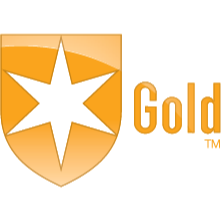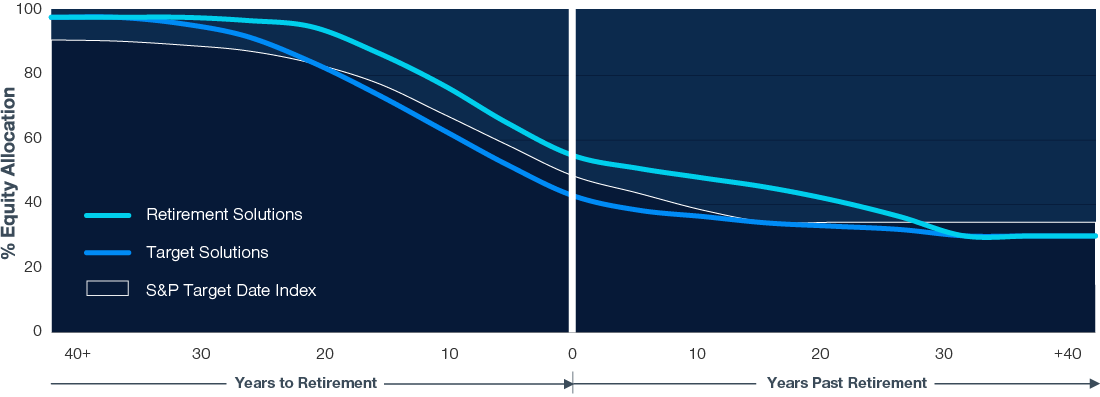
Target Date Capabilities
Feel retirement certain
At a glance
20+
50+
$553B
We deliver outstanding retirement outcomes grounded in three key principles
Putting your needs first
Because we understand your needs and the impact change can have on retirement, we offer a choice of target date solutions to address a range of goals and real-life objectives—so that you can feel retirement certain.
Uncompromising on risk
Our people-centric approach to managing risk is centered on one thing: helping achieve retirement goals. We look at the full retirement picture to manage the many risks and opportunities that arise over a lifetime of investing.
Quality and innovation, as standard
You want a target date solution that keeps up with the times. So do we. Our advanced analytics go beyond the average—digging deeper on real-world spending and savings behaviors, market trends, and more to help us deliberately evolve to anticipate and respond to change.
Our insights on issues shaping the target date market
 Allocation Views
Allocation Views
Asset Allocation Viewpoints
In the current investing environment, discover how our Asset Allocation Committee is positioning its portfolios.
 Target Date in Action
Target Date in Action
Building Next-Generation Target Date Strategies Through Personalization
Technology has opened up new opportunities to personalize target date strategies.
 Retirement Insights
Retirement Insights
Building better blends: Part 1 Balancing equity allocations
Selecting the right active and passive equity building blocks.
Quarterly update: See what’s new in target date strategy
Join us as the target date team provides an update and insights related to the markets and our target date strategies.
Retirement Solutions
Align your clients' retirement needs with thoughtful solutions.

Our retirement funds beat passive peers 100% of the time
At T. Rowe Price, we know that better investment returns can lead to better retirement years. Our Retirement Funds have delivered higher returns than comparable passive funds in every 10-year monthly rolling periods over the last twenty years. On average, our funds outperformed by 1.11% annually. This kind of extra return can compound over time and may lead to higher retirement balances.
Compared with combined portfolios of passive target date funds over 10-year monthly periods over the last twenty years through 12/31/24.
The performance data shown is past performance and is no guarantee of future results. Investment return and principal value will fluctuate so that an investor’s shares, when redeemed, may be worth more or less than their original cost. Current performance may be lower or higher than the performance data quoted. To obtain the most recent month-end performance, visit troweprice.com.
View standardized returns and other information about the funds in this analysis. More information on the methodology of the analysis.


Our dedicated team of highly skilled experts are committed to helping you achieve your retirement goals

Wyatt Lee is the head of Target Date Strategies in the Global Multi-Asset Division. He is co-manager of target date portfolios. Wyatt also is a member of the firm's Asset Allocation and Multi-Asset Steering Committees. Wyatt is a vice president of T. Rowe Price Group, Inc., T. Rowe Price Trust Company, and T. Rowe Price Associates, Inc.

Kim DeDominicis is a portfolio manager of the target date strategies in the Multi-Asset Division. She also leads the U.S. College Savings Plan investment efforts. Kim is a vice president of T. Rowe Price Group, Inc., T. Rowe Price Trust Company, and T. Rowe Price Associates, Inc.

Andrew Jacobs van Merlen is a portfolio manager and co-portfolio manager for the target date strategies in the Multi-Asset Division. Andrew is a vice president of T. Rowe Price Group, Inc., T. Rowe Price Trust Company, T. Rowe Price Associates, Inc., and T. Rowe Price International Ltd.
We can help your investments thrive in an ever-changing world
Defined Contribution Investment Only
Retirement Plan Services
Advisor Services
A broad range of solutions designed to meet your retirement needs
For investors focused on driving outcomes to help support income in retirement.
Retirement Series
Focused on delivering the full value of active management to grow retirement savings
Target Series
Focused on delivering the full value of active management and managing volatility around retirement
For investors seeking the best of both worlds: combining meaningful allocations to active to help drive outcomes with passive allocations to lower costs.
Retirement Blend Series
Supported by active management with allocations to areas of opportunity combined with reduced costs of passive
Retirement Hybrid Series
Emphasizes active management with strategic use of passive strategies to reduce costs
Target Blend Series
Makes meaningful allocations to passive investments as it seeks to capitalize on potential market efficiencies and manage volatility around retirement
A solution for every path
Retirement journeys can last for decades. That’s why we offer a choice of outcome-based glide paths, designed to help address differing retirement objectives leading up to, at the point of, and into retirement.
With more choices, we're seeking to deliver even better results for greater overall value.
Our award-winning retirement products
Morningstar Medalist RatingTM
Retirement Funds — I Class
Analyst Driven: 100%
Data Driven: 100%
People, Process, and Parent: High
Rating as of December 30, 2024

Retirement Blend Funds — I Class
Analyst Driven: 100%
Data Driven: 100%
People, Process, and Parent: High
Rating as of December 30, 2024

Target Funds — I Class
Analyst Driven: 55%
Data Driven: 100%
People, ProcessQ, and Parent: High
Rating as of December 31, 2024

Retirement Trusts
Select classes^
Analyst Driven: 100%
Data Driven: 100%
People, Process, and Parent: High
Rating as of December 30, 2024

Retirement Blend Trusts
Analyst Driven: 100%
Data Driven: 100%
People, Process, and Parent: High
Rating as of December 30, 2024

^The Retirement Trusts classes D, E, G, H, J, and K are Gold and the Retirement Trusts classes A, B, C, and F are Silver as of December 30, 2024.
I Class shares may not be available to all participants. Trusts are available only to certain types of retirement plans and may not be available to all participants.
Ratings for other share classes may differ. The Morningstar category for all vintages of the target date series is US Fund Target Date for mutual funds and Morningstar US SA Target Date for trusts.
See Morningstar Rating Disclosure for important information about the ratings.
Discover multi-asset solutions for long-term retirement goals
Learn about our multi-asset capabilities and how they can support your evolving retirement needs.
Explore all of our investment capabilities
Learn more about our investment capabilities designed to meet a full range of client needs.
Frequently asked questions
At T. Rowe Price, we believe knowing is the key to a good retirement.
We want our target date investors to feel retirement certain. Through our decades of managing target date solutions and shaping retirement futures, we have developed a distinct understanding of real-life retirement needs. By asking better questions, we aim to deliver better outcomes.
Three main principles guide our approach to target date investing:
- We put you first: Because we understand how people tend to behave—leading up to, at the point of, and into retirement—and the impact changing markets can have on retirement over time, we factor your evolving needs into every decision we make.
- We are uncompromising on risk: Our people-centric approach to managing risk is focused on helping our clients meet their retirement goals.
- Quality and innovation are part of everything we do, as standard: We deliberately embed quality and innovation into every aspect of our target date solutions.
Because we look at the full retirement picture, our target date glide paths are designed around clients’ needs leading up to, at the point of, and into retirement and the differing retirement outcomes clients want to achieve.
We develop our glide paths based on:
- real-world research and analytics that deliver deep insights,
- retirement saving and spending behaviors, and
- market conditions and trends over time.
Our methodology also incorporates the full range of these attributes, rather than relying on simple averages.
Additionally, our target date glide paths are constructed with purposeful diversification, using building blocks intentionally selected to play a specific role at different stages along the retirement journey. These building blocks are assembled so each component complements the others to work collectively to help drive better retirement outcomes.
And our active approach means we are always looking to ensure we are meeting client needs. While we embrace the fact that retirement journeys can last decades, we are able to monitor and make pragmatic adjustments along the way in an effort to stay ahead of change.
Because we understand our clients’ needs, we offer a choice of target date solutions to address specific goals and real-life objectives. We work in partnership to help you determine which solution may be best aligned for specific outcomes and circumstances.
We offer:
- A full suite of client-focused target date solutions—including active and active/passive blends—designed to meet specific retirement goals.
- A comprehensive range of investment vehicles from mutual funds to collective trusts.
- Goal-driven glide paths based on client investment objectives and participant demographics.
- A range of packaged approaches, including fully bundled, co-branded, and custom solutions.
Contact us to begin the conversation about your goals and finding a target date solution that can help you or your clients feel retirement
certain.
Our people-centric approach to managing risk is focused on one thing: helping achieve retirement goals.
Because we look at the full retirement picture, we can comprehensively manage the many risks and opportunities that arise over a lifetime of investing for retirement. From market volatility to the risk of outliving retirement savings and everything in between, our holistic view means we carefully and continually plan for a range of short- and long-term factors.
It starts with our outcome-based design, developed to address specific retirement objectives. It is further reflected in our purposeful diversification, with building blocks intentionally selected to play a specific role at different stages along a retirement journey.
And while we embrace the fact that retirement journeys can last decades, we are able to monitor and make pragmatic adjustments along the way in an effort to stay ahead of change. That means we can stay consistently focused on what is most important: pursuing the best possible outcomes for retirement.
We are uncompromising on how we manage risk at every step along a retirement journey to help our clients feel retirement certain.
Growth is key in the early stages of a target date fund glide path to help build substantial retirement savings that can sustain investors through potentially long retirements. As retirees live longer, with rising health care costs and inflation over time, growth in the early years of a retirement journey can significantly impact the target date fund’s potential to meet an investor’s retirement needs over the long term.
Because we are uncompromising on risk, we build these longevity risks into our glide path design to best support the needs of our clients.
We build our target date funds with highly diversified building blocks. Our deep and broad investment capabilities allow for global diversification across a range of equity and fixed income asset classes, sectors, and regions.
Each of these building blocks is purposefully selected to play a specific role in the portfolio at different stages of the retirement journey. We put those pieces together with the intention that each component complements the others and works collectively to help drive better retirement outcomes and deliver value to our clients.
While retirement journeys require a long-term focus, we also manage shorter-term risks and opportunities by making tactical adjustments to our target date solutions in an effort to stay ahead of change.
Our approach to diversification also helps address risks and opportunities as we select the underlying building blocks to play a specific role in the portfolio at different stages of the retirement journey.
Through our unwavering commitment to delivering strong retirement outcomes in all market conditions, we help our clients to feel retirement certain.
Investors select target date funds based on their likely retirement date.
When clients are in the early stages of their working years, the glide path emphasizes investment in equities while gradually shifting to bonds as they get older, based on an expected retirement age of 65. And they can adjust their selection based on their specific circumstances. For example, if their time horizon, risk tolerance, or financial situation calls for it, they can consider an investment with a different target retirement date.
Additionally, a target date investment service that allows for personalization for individuals based on an investor’s specific savings goals, preferences, and financial situation, as well as custom target date investment options for institutions are available in certain markets. Contact us to learn more.
Yes. We offer active/passive blended target date solutions that seek to deliver the best of both worlds, combining active and passive building blocks to help clients meet their retirement goals. Our blended solutions balance the benefits of both investment styles and take a prudent approach to return generation and cost containment. Active allocations, with an eye toward delivering better returns than market indexes, provide opportunity to drive better outcomes and support lifetime income. Diversified passive allocations provide lower costs.
By understanding the respective challenges and opportunities across both investment styles, and through purposeful selection of active and passive underlying investments, our blended solutions help deliver value to our clients.
As a leader in the target date industry, T. Rowe Price offers a wide range of investment strategies and vehicles to meet evolving needs of clients. We are committed to offering investments with competitive fees across all our solutions and to delivering value for our clients.
If you would like to discuss how our pricing compares to competitors, please contact us.
The T. Rowe Price Retirement Funds beat their passive peers 100% of the time. They delivered higher returns than comparable passive funds in every 10-year monthly rolling period over the last 20 years, outperforming by an average of 1.11% annually. Results are net of fees. This performance is compared with combined portfolios of passive target date funds over 10-year rolling monthly periods over the last 20 years through 12/31/24. Click here for additional information. Performance for other T. Rowe Price target date solutions can be found here.
Important Information
*Combined target date portfolios include assets managed by T. Rowe Price Associates, Inc. and its investment advisory affiliates as of September 30, 2025. T. Rowe Price Trust Company, as trustee for the T. Rowe Price Common Trust Funds (“Trusts”), has retained the services of T. Rowe Price Associates, Inc. and/or its investment advisory affiliates to assist it in the investment of assets of the Trusts. Figures above include Trusts’ assets.
1Average was time weighted based on the percentage of total rolling performance periods provided by each Retirement Fund.
Analysis by T. Rowe Price. Source: Morningstar. The target date funds included in the combined portfolios were (1) defined as passive by Morningstar as they were listed as "Index-Based" within their Morningstar Institutional Category, and (2) with Morningstar universe sharing the same target date as each Retirement Fund. Combined portfolios were equally weighted and based on the oldest share class of each competing passive target date fund. The Retirement 2005 Fund was excluded from the study, as it had a limited number of passive peer constituents in the Morningstar universe; the Retirement 2065 Fund was excluded due to lack of a 10-year track record.
Although in the same category, there may be material differences among target date funds, including fees, expenses, and the portfolio mix of investments. Active investing may have higher costs than passive investing and may underperform the broad market or passive peers with similar objectives. Passive investing may lag the performance of actively managed peers as holdings are not reallocated based on changes in market conditions or outlooks on specific securities. Results for other time periods will differ.
The T. Rowe Price target date trusts, and their underlying trusts (the Trusts) are not mutual funds; rather the Trusts are operated and maintained so as to qualify for exemption from registration as mutual funds pursuant to Section 3(c)(11) of the Investment Company Act of 1940, as amended. The Trusts are established by T. Rowe Price Trust Company under Maryland banking law, and their units are exempt from registration under the Securities Act of 1933. Investments in the Trusts are not deposits or obligations of, or guaranteed by, the U.S. government or its agencies or T. Rowe Price Trust Company and are subject to investment risks, including possible loss of principal.
All investments are subject to market risk, including the possible loss of principal. The principal value of the target date funds is not guaranteed at any time, including, if applicable, at or after the target date, which is the approximate year an investor plans to retire (assumed to be age 65). Investments in other funds: The fund bears the risk that its underlying funds will fail to successfully employ their investment strategies. One or more underlying fund's underperformance or failure to meet its investment objective(s) as intended could cause the fund to underperform similarly managed funds. Interest rates: A rise in interest rates typically causes the price of a fixed rate debt instrument to fall and its yield to rise. Conversely, a decline in interest rates typically causes the price of a fixed rate debt instrument to rise and the yield to fall. International investing: Non-U.S. securities tend to be more volatile and have lower overall liquidity than investments in U.S. securities and may lose value because of adverse local, political, social, or economic developments overseas, or due to changes in the exchange rates between foreign currencies and the U.S. dollar. Emerging markets: Investments in emerging market countries are subject to greater risk and overall volatility than investments in the U.S. and other developed markets. See the prospectus for more detail on the fund's principal risks.
CFA® and Chartered Financial Analyst® are registered trademarks owned by CFA Institute.
Important Information About the Morningstar Ratings
The Morningstar Medalist RatingTM is the summary expression of Morningstar’s forward-looking analysis of investment strategies as offered via specific vehicles using a rating scale of Gold, Silver, Bronze, Neutral, and Negative. The Medalist Ratings indicate which investments Morningstar believes are likely to outperform a relevant index or peer group average on a risk-adjusted basis over time. Investment products are evaluated on three key pillars (People, Parent, and Process) which, when coupled with a fee assessment, forms the basis for Morningstar’s conviction in those products’ investment merits and determines the Medalist Rating they’re assigned. Pillar ratings take the form of Low, Below Average, Average, Above Average, and High. Pillars may be evaluated via an analyst’s qualitative assessment (either directly to a vehicle the analyst covers or indirectly when the pillar ratings of a covered vehicle are mapped to a related uncovered vehicle) or using algorithmic techniques. Vehicles are sorted by their expected performance into rating groups defined by their Morningstar Category and their active or passive status. When analysts directly cover a vehicle, they assign the three pillar ratings based on their qualitative assessment, subject to the oversight of the Analyst Rating Committee, and monitor and reevaluate them at least every 14 months. When the vehicles are covered either indirectly by analysts or by algorithm, the ratings are assigned monthly. For more detailed information about these ratings, including their methodology, please go to global.morningstar.com/managerdisclosures/.
The Morningstar Medalist Ratings are not statements of fact, nor are they credit or risk ratings. The Morningstar Medalist Rating (i) should not be used as the sole basis in evaluating an investment product, (ii) involves unknown risks and uncertainties which may cause expectations not to occur or to differ significantly from what was expected, (iii) are not guaranteed to be based on complete or accurate assumptions or models when determined algorithmically, (iv) involve the risk that the return target will not be met due to such things as unforeseen changes in management, technology, economic development, interest rate development, operating and/or material costs, competitive pressure, supervisory law, exchange rate, tax rates, exchange rate changes, and/or changes in political and social conditions, and (v) should not be considered an offer or solicitation to buy or sell the investment product. A change in the fundamental factors underlying the Morningstar Medalist Rating can mean that the rating is subsequently no longer accurate.
©2025 Morningstar, Inc. All rights reserved. The information contained herein: (1) is proprietary to Morningstar and/or its content providers; (2) may not be copied or distributed; and (3) is not warranted to be accurate, complete, or timely. Neither Morningstar nor its content providers are responsible for any damages or losses arising from any use of this information. Past performance is no guarantee of future results.
The above graphic shows a circular chart and bar chart demonstrating the amount and frequency with which T. Rowe Price Retirement Funds delivered better returns than passive peer funds over 10-year rolling monthly periods over the last twenty years through 12/31/24. The circular chart shows that the Retirement Funds delivered better returns in 100% of the 10-year rolling monthly periods analyzed. The bar chart shows 11 bars displaying the average additional annual return delivered by each of 10 Retirement Funds, plus the average of all 10 funds. The Retirement Funds are listed by their specific target retirement year. The average additional annual return for each Retirement Fund is listed as follows: 2010: 0.94%; 2015: 1.00%; 2020: 1.32%; 2025: 1.15%; 2030: 1.54%; 2035: 0.98%; 2040: 1.45%; 2045: 0.77%; 2050: 1.02%; 2055: 0.69%; 2060: 0.30; total average of additional returns: 1.11%. All results are shown after fees and expenses.
These glide paths outline how the mix of stocks, bonds, and other investments adjust over time to help savers achieve their desired retirement outcomes. Both our Retirement and Target glide paths emphasize growth during the early phases of retirement saving and become more conservative over time. The Retirement glide path is focused on delivering the full value of active management to grow retirement savings. At 30 or more years before retirement (assumed to be age 65), the Retirement glide path holds a 98% allocation to equity, which decreases to 55% at retirement and then to 30% at 30 years past retirement, where it remains steady. The Target glide path, which is focused on delivering the full value of active management and managing volatility around retirement, holds a 98% allocation to equity until 35 years before retirement, then decreases to 42.5% at retirement and to 30% at 30 years past retirement, where it remains steady.
202505-4518343
